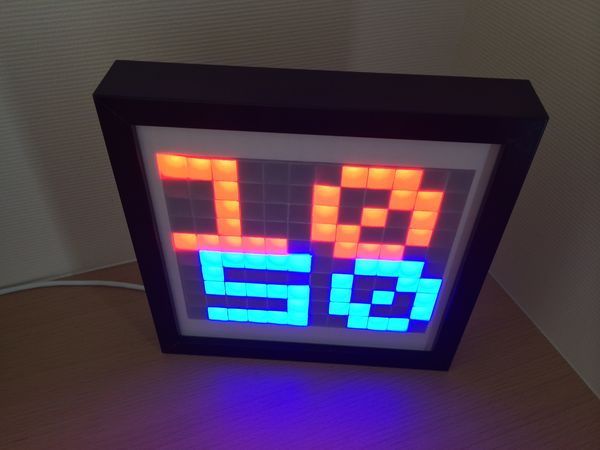Here is a small personal project to brighten my home made from a cheap IKEA photo frame, and Arduino and a multicolor “NeoPixel” LEDs strip. The goal is simple: to realize a matrix of 12×10 big square pixels able to emit light in any color, and controllable from a smartphone. A simple demo video will explain the principle better (the LED flicker is due to the video and not normally visible):
The video shows different working modes of the frame: clock, random pixels, gradual color change, sliding message. It is obviously possible to invent many other modes. Here are pictures of the frame:
The first picture shows the frame itself, with the white cable used to power the LEDs and to control them. The second image shows the power supply and the control circuit. The white cable attached to the frame can be seen. The last image shows the application used to control the frame from a smartphone. Let’s now see how this frame is built.
Material
Let me list what I used to build the frame :
- a cheap IKEA photo frame made for a 23x23cm image, and deep of 4.5cm;
- an Adafruit Neopixel LED strip of 2m with 120 RGB (multicolor) LEDs that can be controlled individually;
- a sheet of tracing paper (23×23 cm at least) to diffuse the light;
- one Arduino Uno to control the strip;
- one Ethernet shield to connect the frame to the local network;
- a 5V 10A power supply to power the strip;
- a 4700μF capacitor to protect the circuit;
- a push button to ask the frame to display its IP address;
- a protoboard to soldier all components;
- a 2,5m cable with at least 3 big enough wires to put a distance between the controller and the display;
- a 5-pin DIN to plug the display into the controller;
- an M3 10mm screw and a nut to close the control box;
- black ABS plastic for the control box and the square pixels;
- some white spray paint for the pixels grid;
- a DS1307+ real-time clock to remember the time and the state of the frame;
- a 0.033MHz 12.5pF quartz to rhythm the clock;
- a lithium CR2032 battery to power the clock when the frame is unplugged;
- two 2.2kΩ resistors to connect the clock to the Arduino (pull-up).
For more detail: A decorative LED frame

